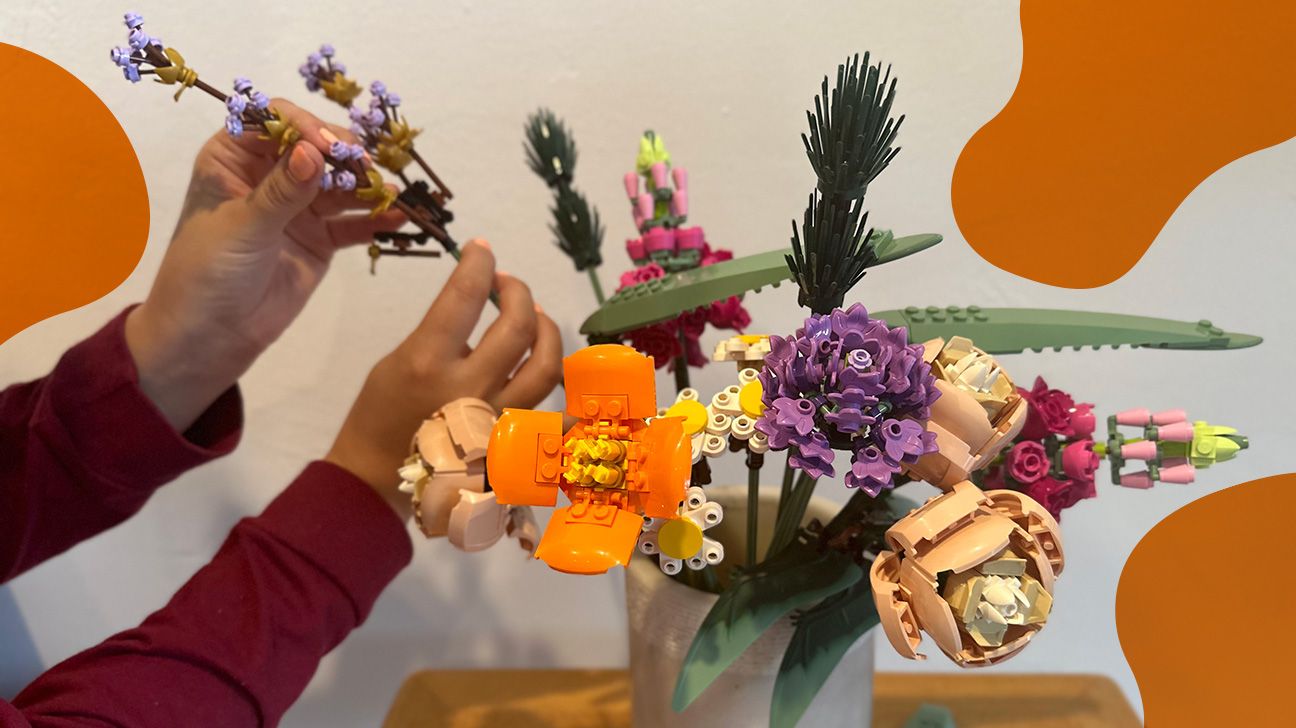Building a Better Life with MS — with LEGOs
April 28, 2023
Content created for the Bezzy community and sponsored by our partners. Learn More

Photo by Matt Verille/Design by Yendi Reid
The classic children’s toy now has building sets aimed at adults, and it’s helped me feel more creative and relaxed while improving my fine motor and cognitive skills.
I was diagnosed with multiple sclerosis (MS) as a teen, but it was only after transitioning into adulthood that I had to get serious about managing my condition. In my late 20s, I was hit with a barrage of symptoms that made me feel like I was losing control of my body. Memory loss, fatigue, stress, and difficulty with fine motor control and problem-solving became part of my daily life.
Searching for ways to cope, I tried a lot of new hobbies in hopes one or more would help me improve some of these skills. So far, I’ve gained the most — in terms of both function and fun — from building 3D objects and tableaus with LEGO sets.


LEGOs for me
Yes, you read that right. I, a grown woman, get immense satisfaction from building with LEGOs.
LEGO, of course, is most well-known as a classic children’s toy. I remember being interested in it when I was a child, but gender stereotypes kept me away from it. Girls were expected to play with dolls, while boys had the freedom to build things. Unfortunately, I carried this belief that I wasn’t supposed to play “boys’ games” into adulthood.
Now, the idea of adults playing games — whether it’s LEGOs, video games, board games, or puzzles — often seems to be frowned upon too. The LEGO Group seems to disagree, however, as the company has expanded its product line in recent years to include sets aimed at adults, with intricate designs and diverse levels of difficulty, like the Orchid and the World Map. Both are currently on my wish list.
I craved creative and accessible stimuli. I decided to break away from societal norms and dove into the world of LEGO building.
But even before I got into LEGOs as an adult, these small, colorful bricks were all over my house, as my young nephew and my almost 40-year-old boyfriend often bonded over this pastime in our living room. I remember curiously watching the “boys” playing with their toys and wondering if they’d let me — a 35-year-old adult woman — join in their fun. What was keeping me from asking?
Way after my diagnosis and deep into my journey with MS, my curiosity finally piqued when I realized I needed support beyond traditional therapies. I craved creative and accessible stimuli. I decided to break away from the societal norms that had kept me away from designing and building with these interlocking blocks.
With great resolve, I pulled up a chair at the family LEGO table and was welcomed warmly. I dove into the world of LEGO building, and what I found was not only a fun and engaging hobby but also a way to strengthen myself cognitively and physically and manage some of my other MS symptoms.
LEGOs for MS
The process of building a LEGO project is akin to solving a 3D puzzle. Each set requires focus, attention to detail, and problem-solving skills. As someone with MS, I actually found meeting this challenge to be incredibly rewarding. I enjoyed discovering how each piece fit together and the satisfaction of seeing the final product materialize into my own masterpiece.
The instructions that came with each set were easy to follow, visually stimulating, and simple.
Each kit contains several bags of LEGO bricks, with each bag containing the bricks for a different section of the project. They eventually join together to form a final piece. This packaging allows me to work at my own pace, tackling one section at a time without feeling overwhelmed.
This super low impact, calming activity allowed me to forget about my stress and fatigue for a while and concentrate on the task at hand. Over time, I found myself less distracted at work and generally sharper.
Building with LEGOs proved to be an effective way to manage some of my MS symptoms. It demanded my complete attention because if my focus was skewed, I easily made an error. So many times, I had to deconstruct and start a section over to figure out where I went wrong, which challenged my problem-solving skills and memory.
This super low impact, calming activity allowed me to forget about my stress and fatigue for a while and concentrate on the task at hand. Over time, I found myself less distracted at work and generally sharper.
In addition, manipulating the varying sizes and shapes of LEGO bricks offered me a unique challenge that helped improve the strength and flexibility of my fingers and hands. Sure, it can be frustrating to fumble and drop pieces, but I found that manipulating and connecting the bricks in a precise and repetitive manner was an excellent way to improve my digits’ dexterity and my hand-eye coordination. Like any exercise, it’s often strenuous. After finishing a bag or two, my fingers are usually fatigued!
Besides being incredibly stimulating, LEGOs are also pretty addicting. Once I completed my first project, I was hooked! I itched for more LEGO puzzles after that initial set left me with a major sense of triumph. The long hours of work had finally paid off, and the finished product was a testament to my resilience and the perseverance of my dedicated fingers.
The takeaway
I have a shelf where I display my finished projects now, and each time I look at them, I feel proud of my accomplishments sprawled along my walls like works of art. The ones I’m most proud of are the Flower Bouquet, The Office set, and the entire LEGO Star Wars Helmet Collection.
Building with LEGOs is not just a hobby for me but also a therapeutic outlet. Engaging in this puzzle-like activity has helped improve my problem-solving skills, memory, and fine motor control. The sense of accomplishment I feel every time I complete a project has had a super positive effect on my mental health and sense of overall well-being.
It’s an engaging and challenging hobby that has brought me immense joy and satisfaction. I’m proud I personally overcame the stigma around adults and women playing with LEGOs. If you’re living with MS or any other chronic illness, I encourage you to give building with LEGOs a try. You might be surprised to discover you love it too.
Fact checked on April 28, 2023


Like the story? React, bookmark, or share below:
Have thoughts or suggestions about this article? Email us at article-feedback@bezzy.com.
About the author